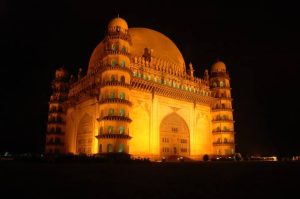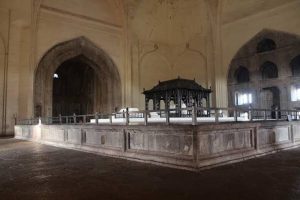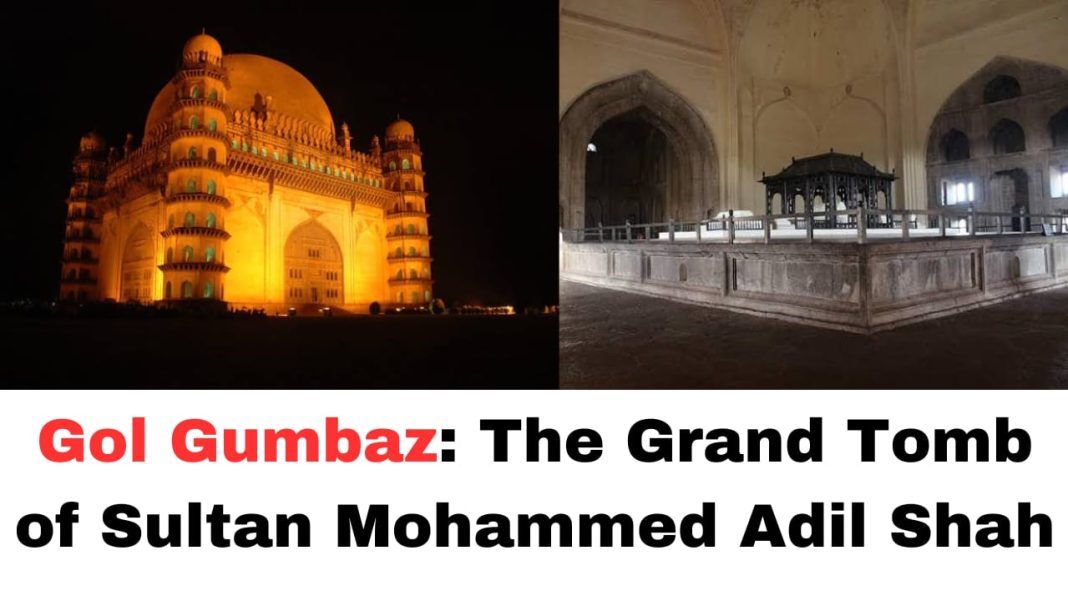Digital News Guru Karnataka Desk:
Gol Gumbaz: The Magnificent Tomb of Bijapur
Gol Gumbaz, one of India’s most iconic architectural marvels, stands as a testament to the grandeur and engineering prowess of the Deccan Sultanate. Situated in the city of Bijapur (now Vijayapura) in Karnataka, this awe-inspiring structure is the tomb of Sultan Mohammed Adil Shah, the ruler of Bijapur, and remains one of the largest domed structures in the world. Known for its distinctiveness in both design and acoustics, Gol Gumbaz is a prime example of the Indo-Islamic architectural style and continues to attract visitors from all over the world.
Historical Context
Gol Gumbaz was built between 1626 and 1656 by Sultan Mohammed Adil Shah, the seventh ruler of the Adil Shahi dynasty, who ruled over the Bijapur Sultanate. The Sultan’s decision to build the tomb was motivated by his desire to create a monumental resting place for himself, and his obsession with grandeur. The tomb is a part of a complex that also includes a mosque, a madrasa (Islamic school), and a few other smaller structures.

The name “Gol Gumbaz” is derived from the Marathi word ‘Gol,’ meaning ‘circular‘ or ‘dome,’ and ‘Gumbaz,’ meaning ‘vault‘ or ‘tomb.’ This is a fitting name given the structure’s impressive circular dome, which remains one of the largest single-chambered domes in the world. The monument’s architectural brilliance, however, is not just its size but also its innovative construction techniques and unique acoustics.
Architectural Design
Gol Gumbaz is a striking example of the Deccan architectural style that blends Persian, Turkish, and Indian elements. The structure is built using locally sourced limestone and features an expansive dome with an internal diameter of about 44 meters (143 feet). The dome, which rises to a height of 51 meters (167 feet) above the ground, was constructed without the use of any supporting pillars, a feat that was revolutionary at the time.
One of the most remarkable features of the Gol Gumbaz is its dome’s unsupported construction. It rests on a circular base with a series of recessed ribs that provide structural support. This dome was designed to be self-supporting, using an ingenious system of interlocking stones. The entire structure is reinforced with thick, massive walls that help distribute the weight of the dome evenly. The skillful engineering behind this design allowed the dome to be one of the largest of its kind, and it remains a marvel of medieval architecture.
The tomb’s layout is also significant. The interior of Gol Gumbaz is divided into two main levels: the ground floor houses the cenotaph of Sultan Mohammed Adil Shah, while the upper level is designed as a prayer hall. The tomb chamber is square, with a central, circular plan that leads to the massive dome. The walls of the tomb are adorned with intricate carvings and decorative elements, many of which reflect the Islamic art traditions of the time. Above the tomb chamber is the ‘whispering gallery,’ a space where sounds can travel across great distances.
The Whispering Gallery
Gol Gumbaz is particularly famous for its unique acoustics, thanks to the so-called “Whispering Gallery” that circles the base of the dome. The gallery’s design is such that a person standing at one end can hear the faintest whispers from the opposite end. The sound waves reflect off the dome’s curved surface, making the gallery an acoustical wonder. A whisper spoken at one point in the gallery can travel to the farthest corner, which is a remarkable feat considering the dome’s enormous size.

The acoustics of Gol Gumbaz have been the subject of much fascination and scientific study. The whispering effect occurs due to the way sound waves reverberate within the circular dome. This phenomenon is not just a natural occurrence but a deliberate design choice by the architect, who clearly understood the science of acoustics. In fact, even the faintest sound, such as the tapping of a finger on the wall, can be heard across the gallery. Visitors often enjoy experimenting with this unique feature, marveling at the way sound is captured and reflected in the structure.
Symbolism and Significance
Gol Gumbaz, with its monumental scale and engineering ingenuity, reflects the grandeur of the Adil Shahi dynasty. The design symbolizes both the power of Sultan Mohammed Adil Shah and the technical prowess of his engineers. The dome, with its vast proportions and precise construction, was meant to convey the Sultan’s authority, as well as his religious devotion. The choice to build such a monumental tomb also reflects the Islamic tradition of grand funerary architecture, seen in structures like the Taj Mahal.
The tomb is not only a symbol of Sultan Mohammed Adil Shah’s personal ambition but also an expression of the Adil Shahi dynasty’s cultural and artistic achievements. It embodies a fusion of Islamic architectural principles with local techniques, resulting in a structure that is distinctly Indian yet influenced by Persian and Ottoman designs.
Preservation and Tourism
Gol Gumbaz is currently a protected monument under the Archaeological Survey of India (ASI) and is a popular tourist attraction in Bijapur. The structure, while showing signs of age, has been well-preserved over the centuries. Restoration efforts have focused on maintaining the integrity of the dome and the intricate carvings that adorn the structure. Though it is centuries old, the monument stands as a reminder of the artistic and engineering achievements of the Deccan Sultanate.

Today, Gol Gumbaz attracts thousands of visitors each year, including historians, architects, and tourists eager to experience its historical significance and architectural wonder. It is also part of the Bijapur city’s heritage, alongside other historical landmarks such as the Ibrahim Roza and the Bijapur Fort. The tomb remains an important symbol of the region’s rich past and a key example of Indian Islamic architecture.
Conclusion
Gol Gumbaz is not merely a tomb but a monumental achievement in engineering, acoustics, and architectural design. It encapsulates the grandeur of the Adil Shahi dynasty and continues to captivate visitors with its sheer size, acoustic wonders, and artistic elegance. As one of the largest domes in the world, it remains an enduring symbol of India’s rich architectural legacy. Gol Gumbaz’s impressive scale, innovative design, and enduring beauty ensure that it will remain a marvel for generations to come.
You May Also Read: Exploring Badami: Karnataka’s Ancient Rock-Cut Temples and Heritage








